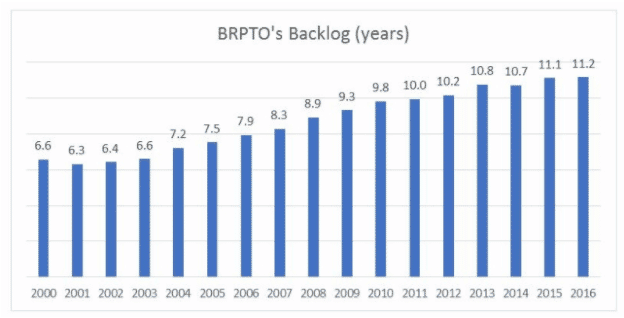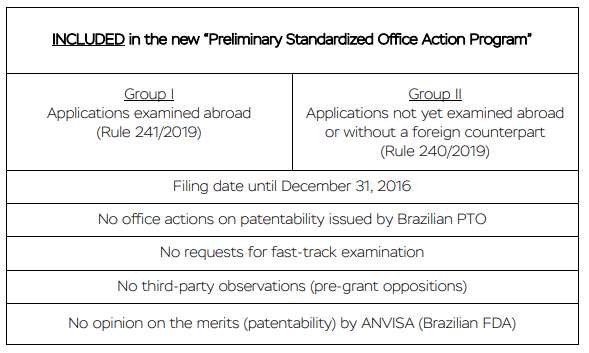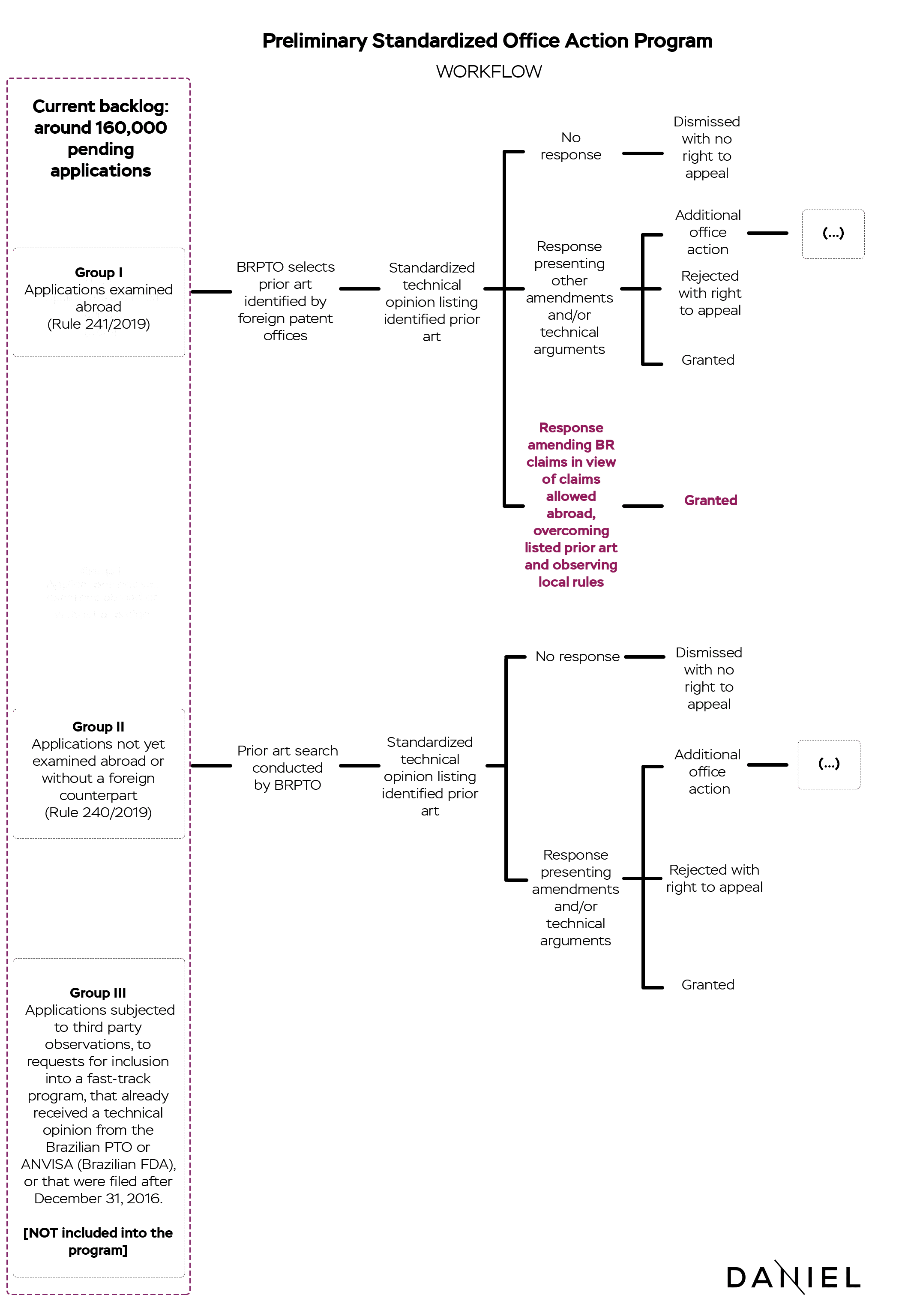The days of one of the world’s most severe patent backlogs are numbered. The Brazilian PTO has just implemented a bold new program to get rid of its enduring patent backlog problem within the course of the next 2 years. The groundbreaking project is called “Preliminary Standardized Office Action Program” and relies on the use of machine-made technical opinions that will simply point out prior art documents to be addressed by applicants. Once the backlog is finally dealt with until 2021, the PTO estimates to be able to take less than 24 months to examine future patent applications.
Background
For the past 15 years, Brazil has been struggling with one of the world’s most severe patent backlogs. The problem has grown considerably after the enactment of the 1996 Patent Statute, which made Brazil compliant to the TRIPS Agreement. The amount of patent filings skyrocketed ever since, as patents were now available to fields not previously patentable, such as pharmaceutical technologies. Hence, in a 15 years period, the amount of applications rose about 200%, without a correspondent increase in the number of examiners within the Brazilian PTO.
As a result, waiting time averages in Brazil used to surpass the 10 years mark for nearly all technological fields. The overall average consisted of 11.5 years from filing until grant, but some areas bore a much graver backlog. As a matter of fact, the backlog for applications in the telecom field reached an astonishing 13,74 years average. At its turn, pharmaceutical applications did not fall short, as the average waiting time reached 13,27 years for traditional drugs and 12,04 years for biopharmaceuticals.

In recent years, the Brazilian PTO has committed itself to reduce the patent backlog through the implementation of many different strategies, including: (i) hiring new examiners, optimizing internal procedures, implementing new technology and IT solutions; (ii) creating several fast-track programs, that cover from green technologies to health-related applications, and signing multiple Patent Prosecution Highway (PPH) Agreements with patent offices around the world; and (iii) implementing the “Pre-examination Office Action Program”, taking advantage of the examination of foreign counterpart applications that were carried out by other patent offices abroad.
With all those recent efforts, the Brazilian PTO was able to significantly reduce the patent backlog, which went down from an average of 11.5 years to a little more than 8 years. In addition, it is important to bear in mind that the Brazilian Patent Statute establishes an automatic extension in the term of validity of a patent in cases where the Patent Office takes more than a decade to grant the application. Accordingly, the protection is granted for 20 years counting from the filing date or 10 years counting from the date of grant, whichever the longest. Nevertheless, the backlog is certainly still a major problem that had to be addressed.
In late 2017, an “emergency” measure was put into discussion: the past administration introduced a plan to automatically grant over 200,000 patent applications without any examination whatsoever. The proposal consisted of a simplified examination procedure, according to which the Patent Office would automatically grant applications filed until a date yet to be established, against which no pre-grant oppositions had been filed and that have not been examined yet. Eventually, this highly controversial measure was not adopted, but the new government kept in mind the need to solve the backlog problem.
It is within this context that the recently announced new solution arose, which is heavily based on the mechanism of the previous “Pre-examination Office Action Program” – a program that allowed the Brazilian PTO to rely on the examination performed abroad by foreign offices to speed up the analysis of local applications that already had examined foreign counterparts.
Given the importance dedicated to it, the new program was announced with pomp and circumstance during an official ceremony by the Brazilian Economy Minister, Mr. Paulo Guedes, and by the President of the Brazilian PTO, Mr. Claudio Vilar Furtado, as part of the efforts of the current administration to modernize the Brazilian business environment, which included the country’s accession to the Madrid Protocol in early July.
The mechanism of the program
Basically, the program divides pending applications into three different groups:
Group I – applications for which a respective foreign counterpart was already examined;
Group II – applications that do not have a foreign counterpart examined abroad; and
Group III – applications that were subject to third party observations (pre-grant oppositions), to requests for inclusion into a fast-track program (PPH or Priority examination), that already received a technical opinion from the Brazilian PTO or from ANVISA (Brazilian FDA), or that were filed after December 31st, 2016, which are not encompassed by this new program.
Regarding Group I, the PTO will publish a standardized office action simply listing the prior art references identified by a foreign patent office. For applications in Group II, the PTO will carry out a search and publish a standardized office action just listing prior art documents found on such search. In both cases, applicants will have 90 days to present a response to standardized office actions, otherwise applications will be dismissed with no right to appeal.
Group III applications will follow the regular examination, as they are not encompassed by this new program. Accordingly, applications that do not meet the cumulative requirements mentioned above for the other groups will fall under Group III and will not be subject to the standardized office actions created by the new program. Divisional applications will fall under Groups I and II of the program only if the parent application also complies with the requirements above.

The key to the program is therefore the use of standardized office actions that will neither bring specific technical comments on patentability nor formalities regarding the claimed subject matter. They will merely present a list of prior art documents – it will be up to the applicants to address them as they see fit, either amending the set of claims and/or presenting technical arguments in view of the listed prior art. The Brazilian PTO plans to issue unprecedented 2,000 of these office actions per week, which will significantly increase the workload on both applicants and local IP firms.
Nevertheless, the preliminary standardized office action may not be a final opinion. Further technical opinions may be later issued on patentability or formalities, including clarity, sufficiency of disclosure, and other issues. However, substantive examination taking place after the issuance of these standardized office actions will be limited to prior art documents listed on the standardized office actions, that is, there will be no additional searches at a later point.

One important observation to keep in mind when amending the claims in response to the standardized office action is the necessity to comply with Brazilian rules related to claim amendments. After the request for examination, Brazilian PTO does not allow applicants to amend the claims to make them broader or to include new claim categories, that is, applicants can only amend the claims to make them narrower or clearer.
Other important observations include:
• Amend the claims to mirror the ones already allowed by a foreign patent office, remembering to comply with Brazilian rules for claim amendments and patentable subject-matter;
• Pay supplementary examination fees if the amended set of claims contain more claims than the one for which the examination was requested;
• In addition to amended claims, present a complete copy of the application containing specification, abstract, drawings, sequence listing etc, in order to make the process easier for the examiner;
There is an inescapable atmosphere of enthusiasm amid the industry with the new program, as it seems to be a game changer and a major positive development towards solving a critical issue for companies doing business in Brazil. The program is off to a good start as the first standardized office actions have already been issued. Once the goals are fulfilled, the expectation is that the Brazilian PTO will finally stand on equal footing with its foreign counterparts in the developed world.
Article published in the Managing Intellectual Property, read here.
